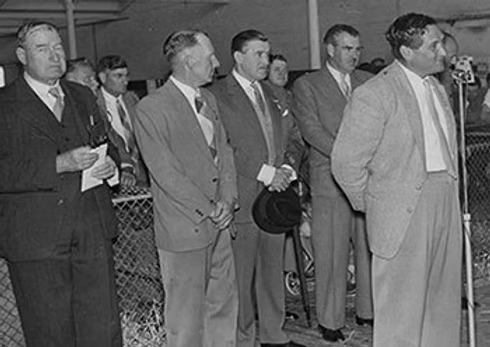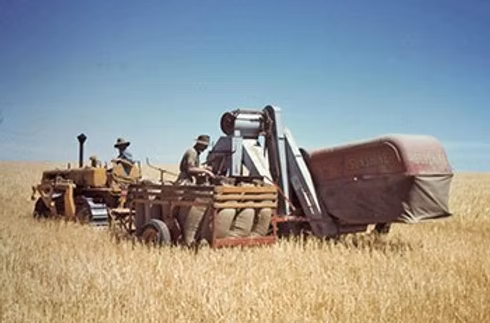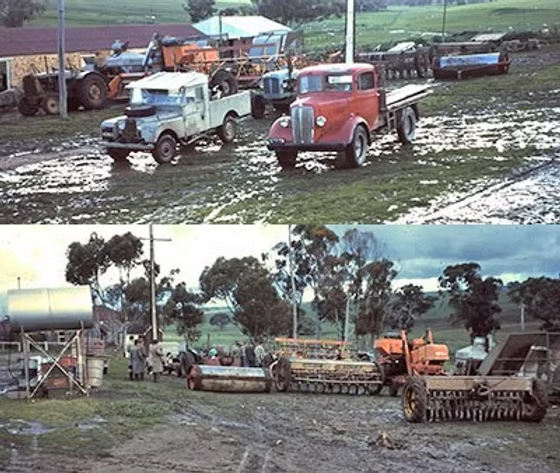First Australian Scholar
Remembering the effect of the first Nuffield Scholarship. By Kim Kelly, 1978 Nuffield Scholar
In their reports, we see time and again the effect the Nuffield Scholarship has on returning scholars. This has evolved from the ever-developing and improving structure of the Nuffield Scholars’ programme. This in turn is brought about by the vision of present and past Nuffield Scholarship executives and people like Jim Geltch. It has reminded me how the Nuffield Farming Scholarship affected my father Bert Kelly, one of the first Nuffield scholars from Australia, in 1951. I was eleven when he went and can well remember the effect the scholarship had on our family and our farm. The memory of what it did for Bert encouraged me to achieve a Nuffield Scholarship in 1978. What I would like to do, before the memories slip away completely, is to pass on to present scholars how the lessons learnt from the scholarship were so different back in 1951. However, the impact on the scholar’s life was very much the same. I think this proves the longevity and relevance of the Nuffield Scholarship to farmers across the decades.
How different farming was in 1951! I was recently at the Lucindale field day, looking at self-propelled spray plants that were so wide I could hardly see the boom ends. Huge headers with cabins like aeroplane cockpits and controlled by computers. Huge tractors that steer themselves and are filled with hydraulics for every sort of use.
In 1951 Bert had brought the farm through the depression years and wartime stresses and for the first time in a long time money was available because of the wool boom, although materials were still in very short supply. I would like to try and paint a picture of Bert’s situation before he went on his Nuffield scholarship, which at that time was run by Lord Nuffield’s organisation.
Bert had been brought up on stories from his father, my grandfather WS Kelly, of the small-scale traditional, poor productivity of British agriculture. WS was wounded toward the end of World War 1 and while recuperating in England he undertook, with the help of the Australian Wool Board, to take AIF soldiers on leave to the northern woollen mills to learn about that end of the wool industry. The success of this experience led to WS organising other soldiers to be sent out to visit various stud breeders to learn all they could about animal husbandry.
After the war and before the depression, WS went to Canberra as a member of the Tariff Board and the Meat Board. When World War 2 started and Britain was running short of food, WS, because of his previous work in England, was asked to come over and help to increase their agricultural production. So Bert would have gone on his Nuffield in 1951 believing the stories from WS, that British agriculture was still run the same way it had been before and during the war. Of course, a lot had happened since, because Britain nearly ran out of food during the war and there had been a huge push since to make agriculture more productive: Britain was determined to never be caught short again.
In 1951 Bert was very much involved in soil conservation in the State. In his book “Merrindie A Family’s Farm” he tells how he constructed the first contour banks certainly in SA. This led to him being on the Soil Conservation Committee. The family had had a long involvement with the South Australian Agricultural Bureau movement: WS had been a past Chairman of the Advisory Board of Agriculture and was involved in its formation. This was the over-arching body for the Agriculture Bureau movement, a very effective grass-roots connection between farmers, extension and research people. Bert followed on and was Chairman of the Advisory Board of Agriculture in 1951. He was also Chairman of the committee of the breed society of Australian Breeders of British Sheep, and a Director of the Royal Adelaide Show.I will now try to give a picture of some the farm machinery Bert was using on “Merrindie” when he left for his 1951 Nuffield.



These were typical seeding machinery around 1951. This Oliver 90 was right up-to-date; in fact it may not have been on the place in 1951. Small D2-size crawlers were used before this rubber- tyred monster. The crawlers had one advantage in that steering reins and a clutch pull could be rigged up so one could be on the combine and still drive the tractor. You can see the tractors of the time were there for pulling only, with no thought of hydraulics or three- point linkage. You can imagine Bert’s surprise to find Britain with self-propelled headers, bulk handling and grain-dryers.
So Bert left on his Nuffield with WS’s stories of English agriculture ringing in his ears. He left also with Australian agriculture in the midst of a wool boom, so he could have well felt superior to those British farmers struggling after the war. He arrived at his host John Rowsell’s farm in the chalky soils of Hampshire. John had been one of the first English farmers to win a Nuffield scholarship, to New Zealand in 1950. These chalky soils of Hampshire had changed agricultural practices. They had always been considered poor soils and not very productive, which led to larger holdings. With new techniques and new machinery, these poor soils were now producing very well.
In his report Bert describes wandering around the farm on his first day expecting to find the farm using horses and the like. After coming on a large modern piggery and poultry sheds; modern grain harvesting machinery with grain driers; tractors of varying sizes with hydraulics to do all sorts of jobs and poultry houses being moved across the place to fertilise to the fields, he was in shock. Eventually he came across one horse and he said he fell on its neck with relief. In his Nuffield report (now on the Nuffield website) he writes about how the intensity, efficiency and the monetary returns of this farming affected him. You have to remember that at home he was using tractors only designed to pull, and grain was still being harvested by ground-drive headers into bags. The agriculture at home was low-cost, low-productivity that worked if seasons and prices were good.
So he continued on his Nuffield, discovering a very productive British agricultural scene. For sure, it was high-cost and was backed up by huge farm subsidies, but it was very productive. He got to Harry Ferguson and was able to see what properly designed tractors could do, and worked with Rex Paterson and discovered the use of hydraulics and three-point linkage. He came back determined to try to increase the productivity of our farm. Now of course this could be a very dangerous thing to do: we didn’t have the assured rainfall or the backup of farm subsidies. Our markets were a long way away and subject to political changes in foreign countries.
 .avif)
The first thing he did was to purchase two grey T20 Massey-Ferguson (“Fergie”) tractors with the associated implements that went with them. Three-point linkage was completely new. Those grey Fergies with their tiny front tyres… I was 12 years old and they were like a dream; they were so small and ideal for me to drive. I can remember the fights my brother and I had to get to use them. They used to start by moving the gear stick to a certain spot. We have a slide of me at the age of 12 perched on the grey Fergie on top of a wedge shaped silage stack made of only artichoke thistles. It was before the use of 2-4-D hormone sprays, and with our black cracking ground the perennial artichoke thistle was a major problem. Here we were able to put this useless plant to good use; using a Patterson buck-rake we were able to pick up the mown pasture and take it to the silage stack. We used to get so much on the buck-rake the front wheel of the tractor used to come off the ground. This was fun because the only way you could steer the tractor was by using the steering brakes.

Many of the other implements were really not much use for our broad acres because they were too small. A two-furrow disk plough was fine for England but not much use here. It did get used for digging out rabbit warrens, pipe trenches and the like. This again highlighted how good the three-point linkage was.
The next two pictures were taken in 1958. Bert was still a director of The Royal Adelaide Show. At that time the Show executive used to do a trip around various parts of SA to create publicity for the upcoming show. This year it was the Mid-North’s turn and as he was a Director, Bert was asked to organise the tour in our area. The usual thing was for the organising Director to show off whatever show animals they had in their stud. Bert quite rightly knew that the travelling press and Show executives would be sick of having show animals paraded before them, so he decided to show the travelling circus the sort of investment that a progressive sheep and grain farmer had to have in machinery. You can see, not only that 1958 was a very wet year, but also the huge development that had happened with farm machinery since 1951. These pictures show the effect of the Nuffield trip on the farm only seven years after Bert’s scholarship. There are 2 Grassland forage harvesters; a Fordson Major tractor; a self-propelled windrower; a Case Allcrop header and diesel fuel tanks, plus other machinery used to increase the productivity of the farm (at the end of 1958 Bert was elected to The House of Representatives as member for Wakefield).

Bert was very taken with the idea of chooks being used to fertilise the farm. He had seen rows and rows of movable poultry sheds being shifted across the fields every few days; the land thus being cheaply fertilised. I suppose the attraction came with his involvement with soil conservation. He was able to bring out a very capable ten-pound Porn who was very good at building things. So he was set to work to build a movable chook shed. The next thing was to get the chickens, which came as hundreds of day olds. Unfortunately the first brooding set up was done in the Kelly way with some short-cuts that led to the whole setup catching alight and incinerating the chickens.
Mobile chicken sheds
Not to be deterred, a new attempt was made and a new batch of chickens grown out. At last they were ready to go out into the beautiful mobile chook shed. The first night they were out there half of them got eaten by foxes. As a 12 year-old I was told to get out there with my trusty .22 rifle and guard the rest of the chooks. I was pretty terrified of being eaten by a marauding tiger, so I slung my hammock, from which I was going to keep watch during the night, high up in the trees away from the tigers. This made it very hard to get into and impossible to do anything if a murderous fox would appear. As it was I quickly went to sleep and woke in the morning to find the rest of the chooks had been eaten by the fox. The beautiful new mobile chook shed was towed into the plantation near the house, never to be moved again.
The Case Allcrop small seed harvester that paid for itself by one day’s harvest of chou moellier
At Rowsells and other farms Bert saw very profitable small-seed growing being achieved. In 1945 he had had success with growing mustard and the story is in his book on “Merrindie”. So he came back fired up to have a go at small-seed production. The family folklore has it that after the successful mustard growing year they celebrated with a mustard party. They must have had a go at canola too, which at that time was still being called rape. At the mustard party my mother Lorna, not thinking, announced if they had a good crop of that they could have a rape party… After his Nuffield experience Bert purchased a Case header, set up for reaping small seeds. He managed in about 1954 to grow a very good crop of chou moellier at a time of record crop failures around the world. The extreme prices received for this crop paid for the Case header in one day’s reaping. Other small seeds were tried such as ryegrass and cocksfoot but with little success, and the Case header was retired to the shed until sold.
All this increase in production meant more labour. This needed two more houses built on the farm, so when I took over at the end of the fifties we had five houses on the place. I spent some of my time getting rid of some of these and making use of the others. We now accept that the way to increase productivity is not by increasing labour costs and certainly not by putting more houses on the farms.
Bert’s Nuffield, the first in Australia, brought many changes to our farm. It was all about looking at things in a new light. That still applies to the present-day scholars. Some of the ideas on intensive farming were not suited to our conditions; however, the spur to increase the productivity of the farm was on the money. His Nuffield meant Bert was looking at new ideas and methods instead of plodding down the same old path. The scene was so different from now but the philosophy is the same.
